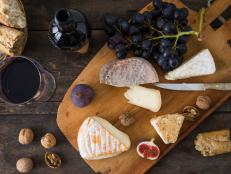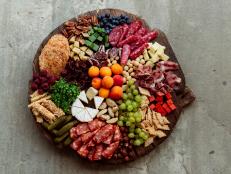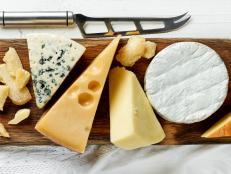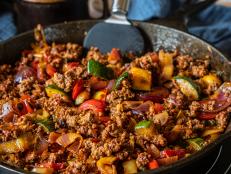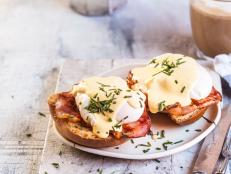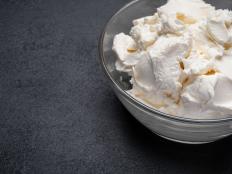The Only Guide to Building a Charcuterie Board You'll Ever Need
Here is the easy, essential plan to creating a board your whole party will love — with lots of details about the best ingredients, tools and arrangement strategies.


Martha Tinkler
Get the Recipe: Perfect Charcuterie Board
The word charcuterie refers to cold cooked, cured, or smoked meats; so, technically speaking, a traditional charcuterie board is just a meat platter. But as these communal boards have gotten more popular for entertaining at home, the definition has expanded to include abundant displays of meats, cheeses, dried and fresh fruits and vegetables, toasted nuts and briny olives, plus complementary condiments like honeys, jams, jellies, chutneys, mustards and more!
A beautiful charcuterie board is a statement piece and a time-saver, since it typically requires little to no cooking. It only takes a few minutes to assemble (really!) and I promise you don’t need to be an expert food stylist. Plus, you can make it ahead of time and pop it in your fridge until right before serving. A charcuterie board can be left out for grazing for up to 2 hours.
Unlike so other many recipes, the key to a good charcuterie board is doing what you want. Choose all your favorite ingredients and whatever you think your guests will love. There are no wrong answers. But if you need a little guidance, this how-to is for you.
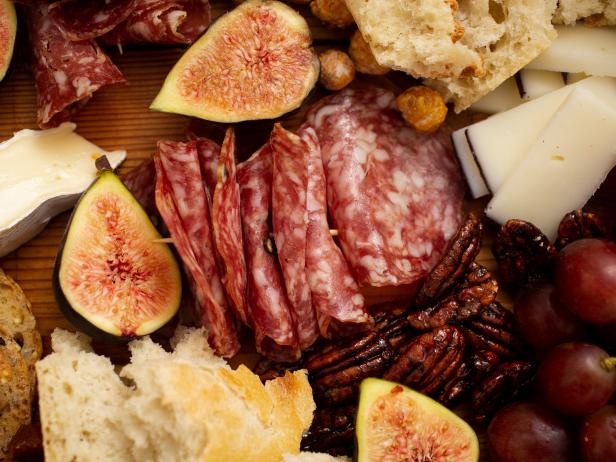
Martha Tinkler
How Much Food Do I Need on My Charcuterie Board?
It’s important to remember that your board is an appetizer, not a main course (unless you are serving it on its own — we’ll get to that below), so you don’t need a half or quarter pound of meat per person, as you would for an entree.
Meats: Two to three slices of meat, or approximately 2 to 3 ounces per person should satisfy your guests ahead of the rest of the meal. Per-pound prices might give you sticker shock, but many are best sliced wafer thin, so a few ounces go a long way. If you’re serving 8 – 10 people, you will need 1 – 1 1/2 lbs of meat, and you’ll want to pick at least one from each category (more on that below) .
Cheeses: It’s usually sliced a little thicker, so 3 ounces of cheese per person or 1 1/2 – 1 3/4 pounds in total for 8-10 people (roughly 3 medium-size hunks) should do the trick.
Extras: The more the better! My number one complaint about meat and cheese platters at restaurants is that they often don’t give you enough bread. Don’t make this mistake. You’ll want at least one cracker or piece of bread for every slice of meat. Extras — pickles, spreads, nuts, fruits — should all be plentiful. It’s OK if they out-number your meats and cheeses, since your guests may want to play with different flavor combos in each bite. It would not be unreasonable to serve 5-10 handfuls or small vessels of extras.
If you want to serve your board as the main dish, add a little extra of everything and think about adding a salad and a heartier cured meat, like a grilled kielbasa or other smoked sausage.

Martha Tinkler
The Best Meats for a Charcuterie Board
There are as many types of cured meats in the world as there are stars in the sky (well, almost). Curing is an ancient method to preserve protein for later consumption, and the many various regions and cultures around the world have their own styles of charcuterie — even unique breeds of livestock from which the meats are made. Here are a few of the major groups you should pull from:
Dry-Cured Pork: Thin-sliced, fatty and salty, dry-cured pork is a must. Serrano ham, prosciutto, country ham, Iberico ham, capicola and speck are all readily available. Look for meat that is pink or red in hue (not brown or gray) with fat that is white (not transparent or opalescent). You can get it prepackaged or sliced fresh from the deli.
Bresaola: Like prosciutto, bresaola is also dried and cured, but instead of pork, it’s usually made from beef top round, lending it a deeper flavor and more toothsome texture. Look for thin slices, a deep reddish color, and a texture that is not overly dry or cracked.
Salami: Salami is possibly the most versatile and varied. It’s an aged sausage made from ground meat seasoned with a variety of herbs, spices and alliums, then dried and fermented in several styles (like soppressata, finocchiona, Genoa). Smaller salami is best served in thicker slices, while larger ones are best shaved thin. It should be vibrant in color when sliced, and if you decide to allow guests to cleave off their own, make sure it’s not too hard to cut.
Other Fun Additions: Mortadella is a cooked Italian sausage similar to American bologna, sometimes studded with pistachios. It's very tender, without the chew of other cured meats. And you might also delve into meat spreads, rillettes and patés. Rillettes (meat slow-cooked in fat until it reaches a spreadable consistency) and patés (finely ground meat fortified with ingredients like sauterne, truffles, and spices) make are decadent layered on crostini with mustard and pickles. ‘Nduja is a spicy Italian meat spread — great on a crisp cracker topped with a piece of sharp cheese.
Choose one meat from each category — for example, a nice variety might include prosciutto, capicola, bresaola, soppressata, and mortadella. You can buy an equal amount of each or play with proportions if you enjoy one more than the other.
Check out what’s available at your local market and keep your eyes open for sales. Sliced meats are best served within 5 days, and stay freshest wrapped in deli paper.
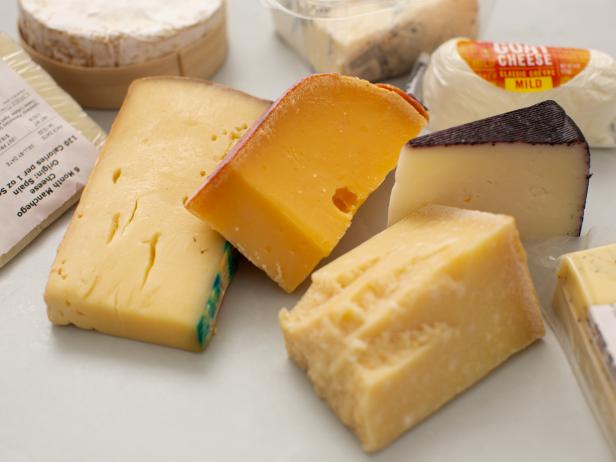
Martha Tinkler
The Best Cheeses for a Charcuterie Board
The cheese is here to complement the meat. Assemble some contrasting textures and flavors: a soft, mild cheese is not going to be the best with soft, mild mortadella, so choose a firm or hard variety of cheese instead. Salamis work well with creamy companions, and prosciutto benefits from burrata or brie.
Soft Cheeses: Brie, Camembert, triple-cream, burrata, goat cheese, fresh ricotta, Gorgonzola dolce. These spreadable cheeses lend tons of flavor and buttery texture. Don’t feel like you must commit to a whole wheel of Brie or Camembert: a slice will often suffice. An oozy Brie with honey and a slice of speck? Heaven!
Semi-Soft Cheeses: Drunken goat, fontina, Muenster, Roquefort, Havarti. These land in the sweet spot between soft and firm, and they are easy to slice on a board. They’re creamy, but not gooey, and are mild in firmness and flavor. Fontina is perfect to mellow out a thick slice of spicy salami.
Firm: Cheddar, Gouda, Gruyère, Stilton, Jarlsberg, Manchego. These cheeses can hold their own in flavor, and a slice will be stiff enough to top and eat without a cracker. Though still creamy like a semi-soft, the firm cheeses offer a little more funk and flavor. Grassy gruyere uplifts ribbony, salty prosciutto.
Hard: Parmigiano-Reggiano, Pecorino-Romano, Asiago, Mimolette. These dry, salty, crystalized cheeses work well broken into hunks or pre-sliced and bring out the best in fatty cuts like soppressata or bresaola.
Cheese is usually sliced much thicker than meat, both by the store and by your guests, so you’ll need a little more than the meat. So pick one cheese from each category, but don’t sweat if you want fewer than four cheeses. Even if you only choose two, that just leaves more room for bread, grapes and other extras.
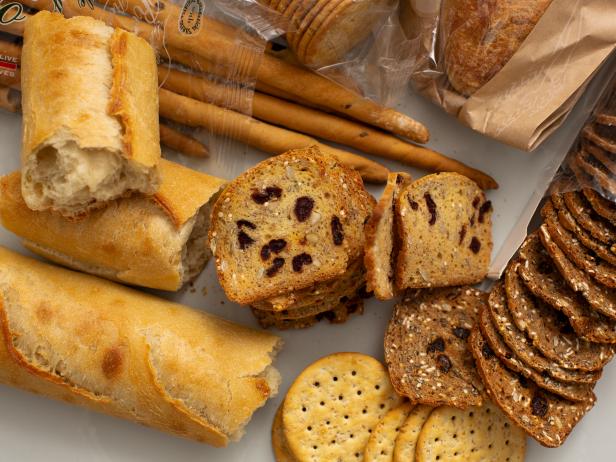
Martha Tinkler
Bites for Stacking and Spreading
To ensure each bite is full of flavors, you’ll need something to keep it all together.
Bread: Try a baguette, toast points, flatbreads, Melba toast, crostini or toasted pita. I like to tear a baguette into chunks with craggy edges, perfect for oozy cheese and sticky spreads. And here’s a trick for making your baguette taste fresh and warm: spritz it with a tiny bit of water, then bake at 350 degrees F for 5-10 minutes. It will crisp slightly on the outside and be warm on the inside!
Crackers and Crisps: There are so many options out there, including gluten-free choices. But never underestimate the plain water cracker, or even the simple saltine. I also like fruit and nut crisps. If you’re feeling ambitious, you might throw in homemade favorites like cheese straws or a seedy option like these crackers.
Fresh Vegetables: These dippers add crunch and color, and balance all the other carb-y options. Broccoli, bell peppers, celery, carrot and radishes are just a few of the myriad of vegetables that would happily join your board. Try a crisp red bell pepper with a creamy muenster and a bit of salami.
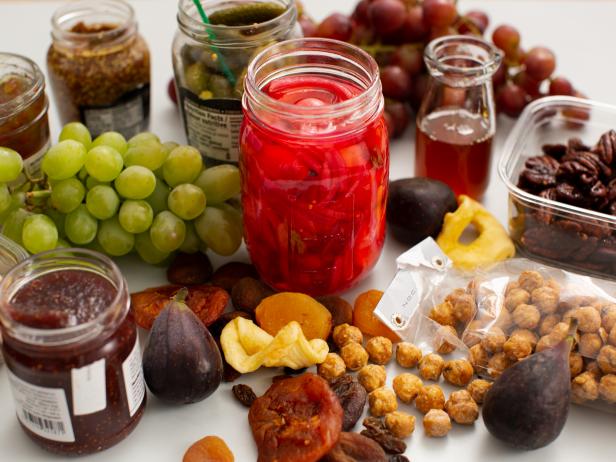
Martha Tinkler
Don’t Forget the Extras
The meat and cheeses are the stars, but don’t skimp on the filler — this is where the board gets fun. Not only fruit, spreads, nuts and pickles usually cheaper than meats and cheeses, but they also satisfy hungry guests. They make the board last longer and keep people happily munching throughout the party.
Nuts: Spiced nuts, candied nuts, Marcona almonds, roasted nuts, nut brittle. I love to make a quick spiced nut or pick up some candied nuts at the store, but even plain roasted nuts are great, crunchy additions.
Fruit: Grapes, sliced apples and pears, dried apricots, dried cranberries, dried and fresh figs. Apples are delicious and are a great cracker substitute for almost any bite. Grapes are a favorite on a charcuterie board for a reason — they don’t oxidize, they are fine room temperature, and they love meat and cheese flavors. And don’t forget seasonal fruits; in late summer peaches and melon are a revelation with prosciutto and brie!
Spreads: Honey, mustard, fig jam, membrillo (quince paste), pepper jelly, sweet or savory chutneys, tapenades. The fun is in experimenting with flavor combos. My favorite tip is to add a pinch of red pepper flakes to honey for a sweet and spicy spread that goes well with almost every meat and cheese.
Pickled/Briny: Brined or oil-cured olives, cornichons, caper berries, marinated artichokes, roasted red peppers and pickled vegetables. These create delightful contrast to the fattier flavors. You can borrow from the Italian antipasto with artichokes and red peppers or dabble in a southern style with bread and butter pickles and pickled okra.

Martha Tinkler
How to Make a Charcuterie Board on a Budget
With so many choices in building your board, it is easy to go overboard and spend $9 on crackers and $30 on a single cheese. But don’t worry, there are ways to build a great board on the cheap.
Look for sales.
There are often sales on meats and cheeses in the specialty section of your grocery store. While fresh sliced options have a limited shelf life, packaged meats and cheeses are good for much longer, so you can pounce early if you spot a sale. And look at the selections in discount stores — people love to shop for board ingredients at Costco and Aldi.
Slice to order.
Didn’t spend weeks watching the prices on soppressata? That’s OK. Go to your local deli and get a few fresh slices instead of pre-sliced packages, which could have more food than you need. The deli scales can help ensure you don’t go over budget!
Go heavy on cheaper extras.
Instead of the fancy crackers, consider thinly slicing a $3 baguette and toasting it with a little olive oil. You’d be surprised how many slices a baguette can offer. A head of celery and a few bell peppers go a long way for just a few dollars.
Stretch those portions.
Stick to your budget with meats and cheeses, and then pre-portion them. Slice cheese into thin slices or small pieces. Prosciutto slices can be very long, and salami slices can be giant. Cut them in half or quarters! Once your guest has sandwiched the smaller meat slice and a little cheese with baguette and a drizzle of honey, they won’t know the difference.
Check your pantry and fridge before you shop.
Use that quarter of a jar of raspberry jam you bought for Linzer cookies, the dried apricots you got on a whim, or the honey for your tea. I have at least 3 mustards and 2 pickles in my fridge at all times. Pour them into a nice little bowl, and they’ll do just fine.

Martha Tinkler
How to Assemble Your Charcuterie Board
Gather your tools ahead of time. I like to stage the board with the empty containers and utensils so I can see how everything will look ahead of time, and make sure that I have enough jars, forks and knives to go around. Sticky notes can also help you plot out where each vessel will go before you commit to placing anything.
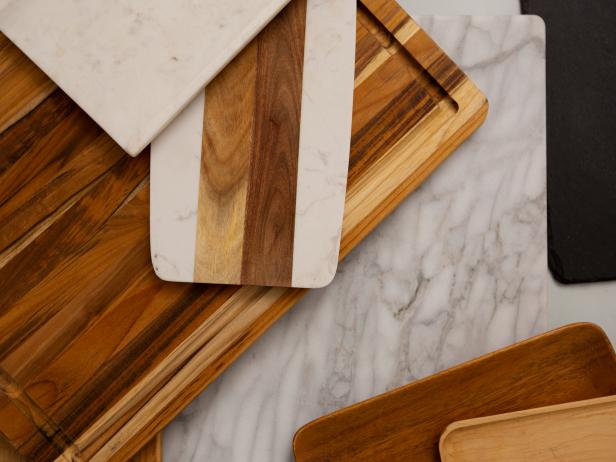
Martha Tinkler
The Board
You need a large slab of something sturdy; I recommend wood, marble, slate or ceramic boards, and there are lots of options in stores and online. Make sure whatever you choose is food-safe — there should be a label stating if it is or isn’t
I have a marble surface that is 16x24 inches and a bread board that is 18x32 inches. They’re both great party boards, perfect for serving 8 to 10 people. They offer plenty of space for lots of fun ingredients, but aren’t so big that you go over budget filling them. A standard cutting board (usually around 12x18 inches) is great for a smaller party (4 to 6 people). You can also create a little island chain of surfaces. Try meats and cheeses on a board with extras, and then crackers and breads in surrounding bowls or plates. You can quarantine particularly strong cheeses to their own plate. You can use a tiered platter. Really, there’s no wrong answer, so have fun with it!
Containers
Instead of serving spreads and pickles in their store packaging, transfer them to cute jars and bowls. But check your home inventory before you buy anything and keep an eye out for nice containers in your everyday life. Hold onto little jam jars and fun vessels to hold honey and other spreads — an eclectic look is fun. You want jars and bowls that are not too high or wide so that the food is all at the same level and easy to access. Call me crazy, but I love a clean baby food jar. It’s the perfect height! (Soak your glass jars in hot, soapy water overnight. In the morning the label should rub right off.)
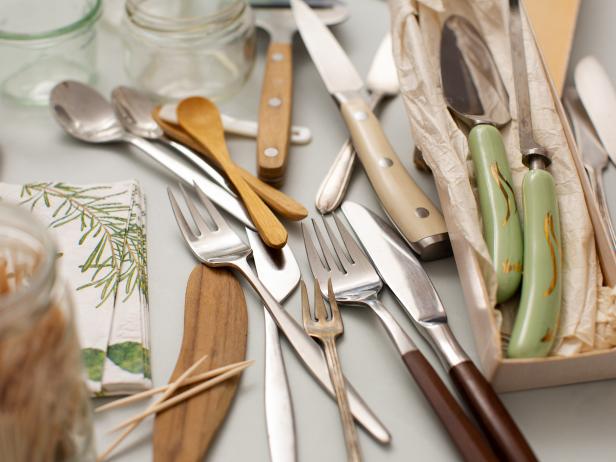
Martha Tinkler
Utensils
Do you have your grandmother’s silver? I bet there’s a shrimp fork or a butter knife that’s perfect for spearing a cornichon or spreading Camembert. I scour flea markets and garage sales for little spoons (a demitasse spoon is perfect), forks and knives. Not into antiques? There’s also a niche market for specific cheese knives and charcuterie tools. But your standard forks, knives, spoons and toothpicks will be totally fine too. The only tools you really need are sharp knives, spreading knives, spoons, and forks or picks. It is not necessary to have a knife for every cheese or a fork for every pickle, but remember that not everything mixes well, and things get messy without at least a few forks and knives. Heaven forbid your jelly spoon ends up in the tapenade!
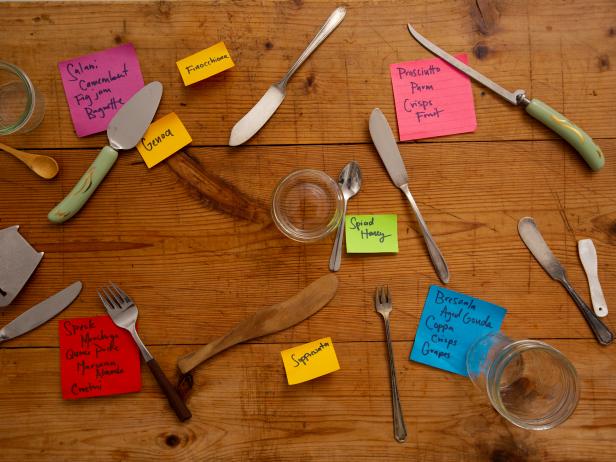
Martha Tinkler
Time to Build the Board
The time has come! Tools are gathered, meats and cheeses are purchased, the mustard you bought from Paris is in a baby food jar and your great aunt’s pewter spoon is sitting on a walnut cutting board. You have curlers in your hair, your mascara is on, but you’re still in a robe and slippers. It’s all happening.

Martha Tinkler
Start with the meats.
Divide your board into quadrants, and place one type of meat in the middle of each quadrant. There are different ways to place the charcuterie: You can shape slices into a rose-like shape, by rolling them like a cinnamon roll. Little clumps and swirls of cured hams are easy and fun. Salamis can be rolled or folded on themselves so they stand up. The most important thing is to make them easy to grab. Never leave them in the flat rows from the deli package. You want to show off their textures.
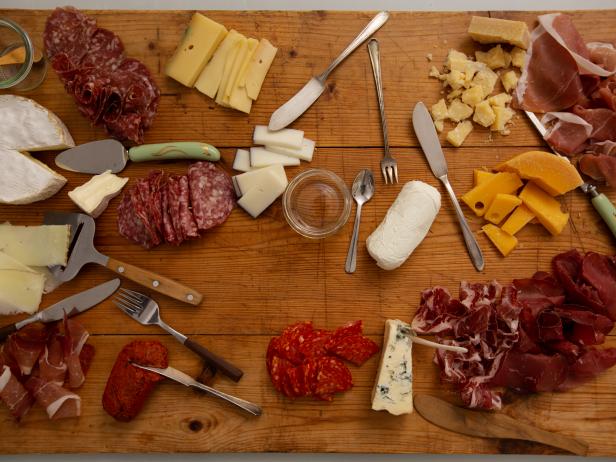
Martha Tinkler
After the meat comes the cheese.
Position the cheeses next to the meats you want to encourage as pairings. And play with angles to keep things jaunty and fun. This is also a great time to rearrange things if they aren’t flowing to your liking.
Hard Cheeses: Slices or crumbles are much easier to deal with than having guests struggle with a knife, plus they’re great for stacking and shingling for extra flair.
Firm/Semi Soft Cheeses: Place a hunk of cheese but also cut a few preemptive slices. That way it’s an easy grab at the beginning, but as the board empties you will have more space to slice the rest.
Soft Cheeses: Leave them whole, but take out a little piece to show everyone that it is up for grabs.

Martha Tinkler
Next, before it gets too crowded, nestle in the jars.
Spiced honey? There’s a nice spot between Parm, bresaola and Brie. Mustard? Think about a classic pairing of ham and cheese — is there space near the prosciutto and the Gruyere? Maybe the pickled vegetables go over there, too. Keep going! You’re doing great.
Now let’s gild the lily!
Get extra with your extras. Fill any blank space with fruits, nuts and vegetables. Don’t feel like they all have to stay together. If you think the Brie and the blue cheese both need pecans, split them up. I love a cascade of grapes, but even small bunches can cascade, so you can break them up if that works better. Scatter dried fruits wherever they fit. If one side is particularly beige, throw in some pickled radishes! More is more.
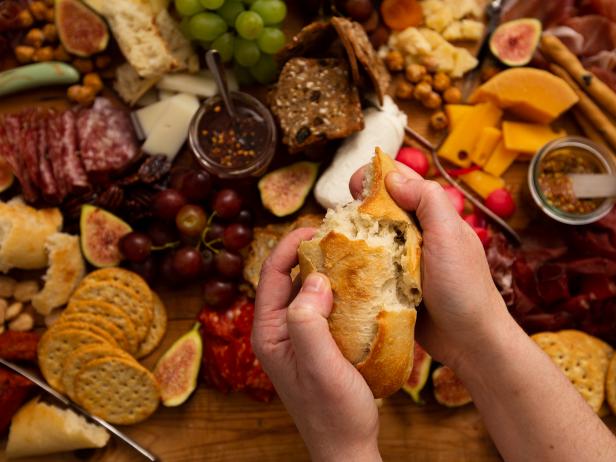
Martha Tinkler
Bring in the bread.
I like to snake a stack of crackers or crostini like a vein through the board. But don’t be afraid to get vertical; stacks are great, and I love lavash or breadsticks standing tall in a mason jar. Feel free to go outside of the board to display as many bread vessels as you want. I find that usually the crackers run out long before the cheese, so keep extras in the back!

Martha Tinkler
Explain your art.
Be ready to answer questions. There’s bound to be an ingredient that is new to someone. Taste-test pairings yourself so that you have a few options for the perfect bite with all the fixins’. Give some suggestions, then let people find their own way.
If you finish your board way ahead of time, place it in the fridge until 30 minutes before guests arrive for peak texture and flavor. Of course you can serve it chilly, but the flavors are more pronounced in a room temperature cheese.
There are so many wonderful things about making and serving a charcuterie board, but what I love is that it’s an adventure to build and to eat. Your guests may discover a combination that never crossed your mind. Like a great painting or poem, the board is up for interpretation. And what’s better at a party than an activity that involves meat and cheese?
Perfect Charcuterie Board
Use this corresponding recipe as a quick reference for ingredient ideas and amounts when you're shopping for your board!
Related Links:
























